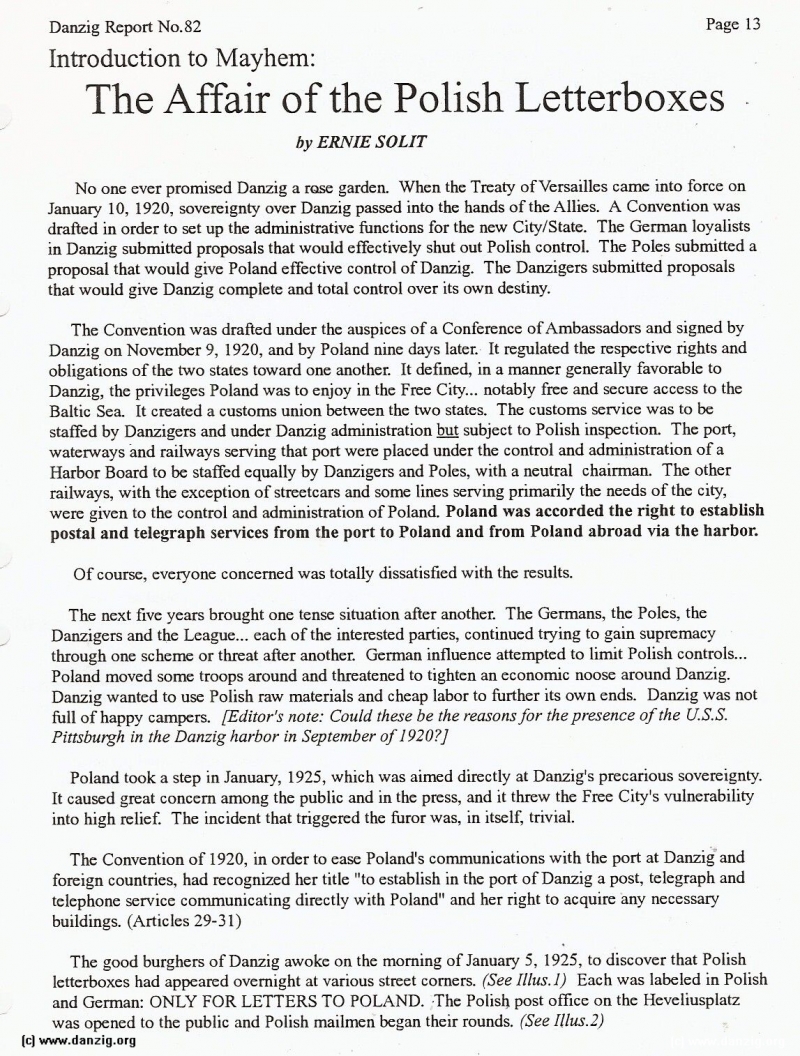
Introduction to Mayhem:
The Affair of the Polish Letterboxes
by ERNIE SOLIT
No one ever promised Danzig a rose garden. When the Treaty of Versailles came into force on January 10, 1920, sovereignty over Danzig passed into the hands of the Allies. A Convention was drafted in order to set up the administrative functions for the new City/State. The German loyalists in Danzig submitted proposals that would effectively shut out Polish control. The Poles submitted a proposal that would give Poland effective control of Danzig. The Danzigers submitted proposals that would give Danzig complete and total control over its own destiny.
The Convention was drafted under the auspices of a Conference of Ambassadors and signed by Danzig on November 9, 1920, and by Poland nine days later. It regulated the respective rights and obligations of the two states toward one another. It defined, in a manner generally favorable to Danzig, the privileges Poland was to enjoy in the Free City... notably free and secure access to the Baltic Sea. It created a customs union between the two states. The customs service was to be staffed by Danzigers and under Danzig administration subject to Polish inspection. The port, waterways and railways serving that port were placed under the control and administration of a Harbor Board to be staffed equally by Danzigers and Poles, with a neutral chairman. The other railways, with the exception of streetcars and some lines serving primarily the needs of the city, were given to the control and administration of Poland. Poland was accorded the right to establish postal and telegraph services from the port to Poland and from Poland abroad via the harbor.
Of course, everyone concerned was totally dissatisfied with the results.
The next five years brought one tense situation after another. The Germans, the Poles, the Danzigers and the League... each of the interested parties, continued trying to gain supremacy through one scheme or threat after another. German influence attempted to limit Polish controls... Poland moved some troops around and threatened to tighten an economic noose around Danzig. Danzig wanted to use Polish raw materials and cheap labor to further its own ends. Danzig was not full of happy campers. [Editor’s note: Could these be the reasons for the presence of the US.S. Pittsburgh in the Danzig harbor in September of 1920?]
Poland took a step in January, 1925, which was aimed directly at Danzig’s precarious sovereignty. It caused great concern among the public and in the press, and it threw the Free City’s vulnerability into high relief. The incident that triggered the furor was, in itself, trivial.
The Convention of 1920, in order to ease Poland’s communications with the port at Danzig and foreign countries, had recognized her title “to establish in the port of Danzig a post, telegraph and telephone service communicating directly with Poland” and her right to acquire any necessary buildings. (Articles 29-3 1)
The good burghers of Danzig awoke on the morning of January 5, 1925, to discover that Polish letterboxes had appeared overnight at various street corners. (See Illus. I) Each was labeled in Polish and German: ONLY FOR LETTERS TO POLAND. The Polish post office on the Heveliusplatz was opened to the public and Polish mailmen began their rounds. (See Illus. 2)
Danzig Report Vol. 1 - Nr. 82 - January - February - March - 1994, Page 15.
Hits: 3428
Added: 06/07/2015
Copyright: 2025 Danzig.org

